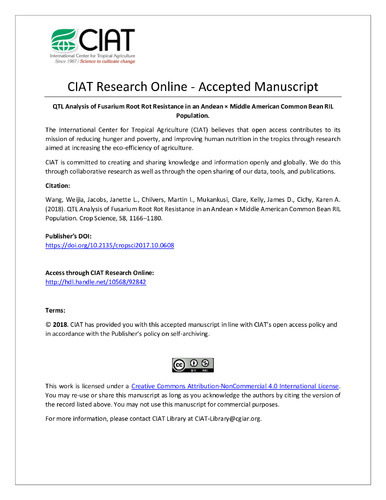QTL Analysis of Fusarium Root Rot Resistance in an Andean X Middle American Common Bean RIL Population
Fusarium root rot (FRR) is a soil‐borne disease that constrains common bean (Phaseolus vulgaris L.) production. Its causal pathogens include clade 2 members of the Fusarium solani (Mart.) Sacc. species complex. Here, we characterize common bean reaction to different Fusarium species and identify genomic regions associated with resistance. Four Fusarium species—F. brasiliense T. Aoki & O'Donnell, F. cuneirostrum O'Donnell & T. Aoki, F. solani sensu stricto, and F. oxysporum Schltdl. sensu lato—were tested for virulence on two bean genotypes, ‘CAL96’ (Andean) and ‘MLB‐49‐89A’ (Middle American), and virulence varied from mild to strong. The recombinant inbred line population of CAL96 × MLB‐49‐89A was phenotyped in a greenhouse for FRR resistance with the F. brasiliense isolate and screened in the field under natural FRR disease pressure. Quantitative trait locus (QTL) mapping was conducted on a map developed with 822 polymorphic single nucleotide polymorphism markers. Two QTLs associated with disease severity score in the greenhouse and field colocalized on chromosome Pv02 (R2 = 0.09 and 0.1, respectively). Other QTLs associated with root–shoot biomass, taproot diameter, lodging, and seed weight were also identified across nine chromosomes. Root and shoot weight QTLs from field and greenhouse screens also colocalized on Pv07 and Pv11. The FRR‐related QTLs identified in this study, especially on Pv02, are good candidates for marker‐assisted selection.

